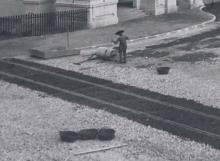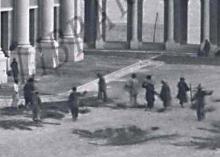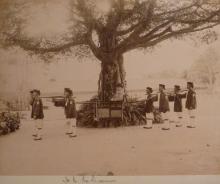KCR Terminus, TST [1916-1978]
Primary tabs
Description from the AMO:
The Kowloon-Canton Railway (British Section) commenced operations on 1 October 1910. The construction of the terminus in Tsim Sha Tsui started in 1913; the clock tower was completed in 1915 as part of the complex, and the whole terminus was opened on 28 March 1916. Built with red bricks and granite in the Edwardian Classical Revival style, the clock tower is 44 metres high and surmounted by a 7-metre lightning rod. The upper part of the tower is an octagonal domed turret built of red brickwork that contrasts with the white-painted classical features of scroll-shaped buttresses, columns and cornices. The main terminus building was demolished in 1978; only the clock tower was left, and it has continued to stand as a landmark in Hong Kong.





Comments
Demolition of the KCR Terminus
Found an image of the demolition works on Flickr, not downloadable. Possibly dating April/May 1978.
Keypoints from newspaper
Keypoints from newspaper article below:
1) The building was opened for public use on the morning of 28th March 1916
2) The offices of the first floor was not occupied until 18th April 1916
3) Kang On was the contractor.
4) Total cost (excluding the foundation) was just south of HK $250,000 (I have transcribed as is, but I think there was a typo error of missing and also adding of an extra digit in some of the figures quoted in the article. Perhaps a separate Legislative Document can confirm the veracity of the newspaper article?)
5) The clock and bell of the clock tower was yet to be be completed in February 1917
“KOWLOON RAILWAY STATION
--------
The following report by Mr. H.P. Winslow, Manager, on the completion of the station building at Kowloon was laid on the table at the meeting of the Legislative Council yesterday.
The building was completed and opened for the public traffic on the morning of the 28th March, 1916. The offices on the first floor were not occupied until the 18th of April owing to causes apart from the question of completion. Kang On’s contract, which was for work to the amount of $173,847, to be completed in two years from 1st March, 1914, actually amounted to a total of $172, 385.63 which included extras for work not shown, or not scheduled by the Architect, or alterations to details for which no prices were provided in the schedule, to the amount of $12, 851.89. The reasons for the completion of the contract being 27 days overdue were fully stated in my report for 31st December, 1915. The platforms and foundations for the building which were done departmentally, cost $53,681.54 against an original sanction of $53,960.89. The original sanctioned amount for the building, apart from foundations, was $250,000, of which the work specified by the Architect was estimated at $202,10.34 including the clock and bell. The total expenditure up to the end of year (exclusive of foundations) is $249,1423.04 which amount after including Kang On’s contract provided for such items as all the steelwork in the building, iron railings, collapsible gates, iron lantern lights, sanitary fittings, pipes and sewers, brass door and window furniture, electric wiring, lighting and lights, telephone installation (3 systems), safes, strongroom door, lightening conductors, 22 electric clocks, public seats, drinking fountain, the water supply and piping, asphalting to flat roofs, all the glazed and flooring tiles, patent flooring to various ground floor rooms, temporary arrangements and moving into new building, Public Works Department’s debits for road approach, extra accommodation for customs, etc, etc. The accounts for the construction of the building have now been closed and all work contemplated in connection with the vote has been completed with exception of the clock and bell for the clock tower.”
Source: The China Mail, page 4, 23rd February 1917
https://mmis.hkpl.gov.hk/coverpage/-/coverpage/view?_coverpage_WAR_mmisp...
Clocktower Clock
As noted here , the clock and bell were installed on 21 March 1921.
Newspaper
The article gives exactly the same text as in the official report shown here.
Different locations proposed for the terminus
This extract from the minutes of the Legco meeting on 29 September 1910 show that at that time three sites had been proposed:
#1, Gascoigne Road was the choice at that time, though eventually it would be built at #3, TST.
F H May said:
Sir Matthew Nathan acquired the land known as Blackhead's Point for the double purpose of forming a railway station and deep-sea wharf. There has been a considerable difference of opinion as to where the terminal station should be placed. As I have said, Sir Matthew Nathan wanted to place it at Blackhead's Point. Then it was decided to place it at Tsim Sha Tsui, and land was acquired for that purpose. Then on further consideration it was decided that to save using that land for railway purposes it would be more economical to revert to a site which was suggested before Sir Matthew Nathan decided on Blackhead's Point, and that is somewhere in the neighbourhood of Gascoigne Road. It is the intention to place the terminal station there, and for the present at any rate to have a flag station at Tsim Sha Tsui. The result will be that the land which has been acquired at considerable cost at Tsim Sha Tsui will be advailable for the Government to dispose of otherwise.
Re: Sites for the Terminus
Fast forward. Blackhead Point would be the site of today's MTR TST East Station.